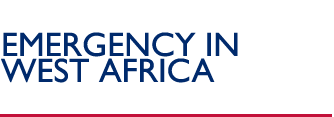USAID Assistance to Niger/Sahel
Background
The U.S. Government has responded quickly and generously to food insecurity and development challenges in the Sahel region of Africa, including Niger. In fiscal year 2005, the U.S. Government, through the U.S. Agency for International Development (USAID), has provided more than $134 million from the American people to programs that will help improve lives in the Sahel and is working closely with the U.N., the governments of the Sahel and other donor governments. These total funds represent direct assistance to the people of Burkina Faso, Mali, Mauritania, Niger and Senegal.
Latest News:
09/16/05 - USAID/OFDA Humanitarian Emergency Fact Sheet #7 (PDF) |
   
|
| COUNTRY | USAID ASSISTANCE |
|---|
| FY 2005 USAID Assistance to Niger | $19,127,521 |
| FY 2005 USAID Assistance to Mali | $39,532,100 |
| FY 2005 USAID Assistance to Mauritania | $16,355,077 |
| FY 2005 USAID Assistance to Burkina Faso | $17,834,500 |
| FY 2005 USAID Assistance to Senegal | $30,917,010 |
| FY 2005 USAID Assistance for Regional Locust Response | $10,331,798 |
| Total FY 2005 USAID Assistance to Niger, Mali, Mauritania, Burkina Faso, Senegal, and Regional Locust Response | $134,098,006
|
|
Regional Update
The Assistant Administrator of USAID's Bureau for Democracy, Conflict, and Humanitarian Assistance (USAID/DCHA), Michael Hess, traveled to Niger and Mali from August 19 to 28 to visit USAID-funded projects in affected areas and conduct humanitarian assessments with USAID Disaster Assistance Response Team (USAID/DART) representatives in the field. Assistant Administrator Hess and his delegation reported that fields are green and crops appear abundant and healthy throughout Mali, and that Niger will probably have a good harvest this year. However, Assistant Administrator Hess expressed concern with household debt levels throughout the region due to household borrowing to survive the current lean season and carry-over debt from the lean season in 2004.
Current Situation According to FEWS NET, recent assessments show consistent rainfall and good crop and pasture conditions in most of Niger and almost all of the rest of Sahelian West Africa. The short-term outlook for these conditions is for continued improvement. Prospects for crop harvests in Niger and the rest of Sahelian West Africa are generally good to excellent, with the exception of certain areas in the pastoral zone of the Tillaberi and western Tahoua regions in Niger; these zones had intermittent rains and an extended dry spell this year. Loss of assets or livestock over the past year may result in continued vulnerability for some families beyond the harvest.
USAID West Africa Regional Program
The USAID-supported West Africa Regional Program (WARP) handles West African development challenges that are most effectively addressed at a regional level. WARP works closely with other USAID missions in the region, including USAID's bilateral missions in Mali and Senegal, and U.S. embassies in countries where USAID does not have a mission. The Sahelian countries benefit from WARP through their membership in such organizations as the West African Economic and Monetary Union, the Economic Community of West African States, and the Permanent Interstate Committee for Drought Control in the Sahel. Overall, WARP supports activities in 19 West African countries, nine of which are in the Sahel. To date, WARP's program totals approximately $40 million in FY 2005.
WARP's four program areas include:
- fostering regional economic integration and trade;
- increasing the adoption of effective policies and approaches to reproductive health, child survival and HIV/AIDS in the region;
- enhancing capacity to achieve regional food security, improved management of natural resources, and agricultural growth; and
- improving the conditions for peace and stability in West Africa.
Continued funding from the Presidential Initiative for Trade for African Development and Enterprise expands the range of goods traded within the region and exported to the U.S. under the African Growth and Opportunity Act, and promotes the principles of the World Trade Organization. Further funding from the Presidential Initiative to End Hunger in Africa is being used to implement the new regional market information system that will supply timely agricultural pricing information to farmers and traders.
USAID Responds to Locust Crisis in the Sahel
Good rains in the northern Sahara south of the Atlas Mountains in late 2003 and early 2004 created favorable climactic conditions for increased locust breeding levels throughout Sahelian West Africa. USAID has monitored and responded to the locust situation since 2003 through its Assistance for Emergency Locust and Grasshopper Activity and Famine Early Warning System Network. During the height of the infestations in the fall of 2004, USAID deployed a Disaster Assistance Response Team to some of the most severely affected areas. According to the U.N., the locust and drought shocks have affected more than 3.6 million people. USAID's Regional Disaster Office has made several trips to each of the Sahelian countries since November 2004 to monitor the effects of drought and locusts. The U.S. Government has responded quickly and generously to locust infestations by providing nearly $14 million to the region. In FY 2005, USAID has provided more than $134 million from the American people to programs that will help improve lives in the Sahel and is working closely with the U.N., the governments of the Sahel and other donor governments. These total funds represent direct assistance to Burkina Faso, Mali, Mauritania, Niger and Senegal, of which nearly $14 million funded locust eradication programs in the region.
More Information
Back to Top ^
|


